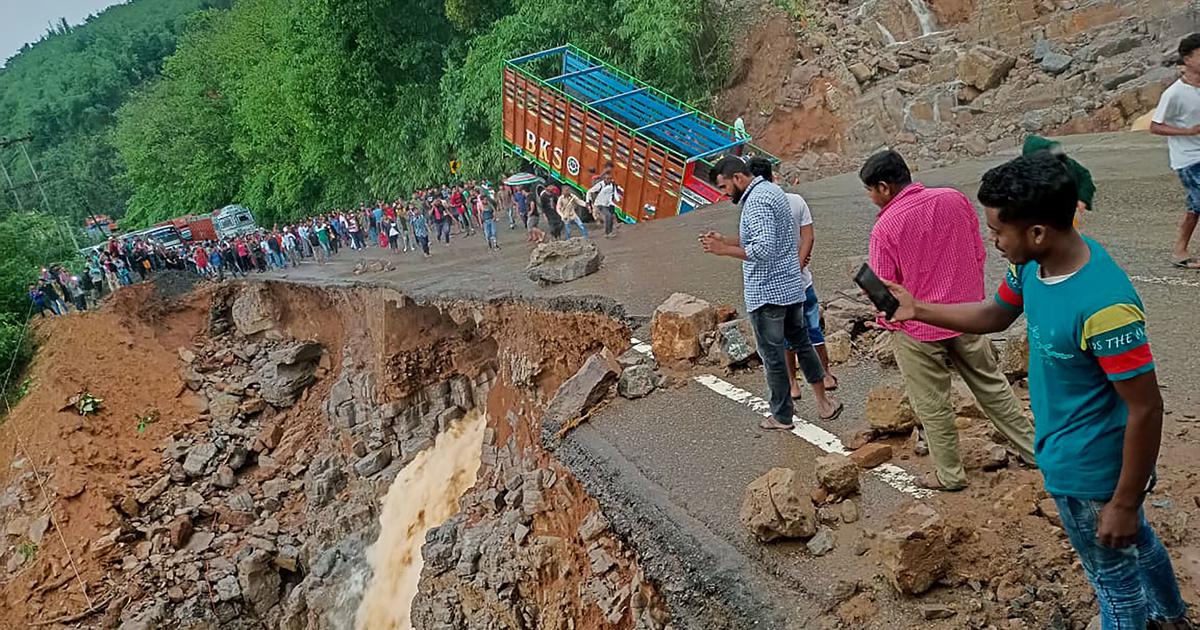Landslides in India

- 29 May 2024
Why is it in the News?
At least 36 people were killed in heavy rains and landslides in four northeastern states on Tuesday under the impact of Cyclone Remal while normal life came to a grinding halt in all the eight states of the region with road and rail links affected.
What are Landslides?
- Landslides in India are one of the major hydro-geological hazards affecting large parts of the landmass of the country.
- It refers to the gravitational movements of a mass of rock, debris, or earth down a slope.
- Landslides are a type of "mass wasting," which denotes any down-slope movement of soil and rock under the direct influence of gravity.
- As per a report from the Geological Survey of India (GSI), 13% of the total land area in India is prone to landslides.
- This covers almost all the hilly regions in the country.
- About 0.18 million square km, or 42% of this vulnerable area is in the Northeastern region, where the terrain is mostly hilly.
What Causes a Landslide in India?
- Deforestation: Removal of trees reduces the binding properties of soil and rocks. This enables the water to seep into the sub-surface, making the topsoil vulnerable.
- For example, the Himalayan region has become more vulnerable to landslides due to the indiscriminate cutting of trees.
- Shifting Cultivation: Shifting cultivation is common in hilly regions and Northeast areas. Every year, residents burn the forests for cultivation purposes.
- However, this deteriorates the quality of topsoil, causing erosion during heavy rainfall. This makes such regions more vulnerable to landslides.
- Heavy Rainfall and Earthquakes: Heavy rainfall and earthquakes often cause landslides.
- For example, heavy rain caused landslides in Talai village of Maharashtra in 2021.
- Mining: Human activities like mining or quarrying remove the vegetation cover and soil gravel. This lowers the groundwater retention capacity. Also, it increases the risk of flooding.
- Therefore, landslides occur due to loose debris or excess floods during an earthquake and heavy rainfall, respectively.
- Urbanisation: Intensive urbanisation and urbanization activities such as establishing commercial housing projects and road construction reduce the vegetation cover which leads to an increasing frequency of landslides.
What Are the Different Types of Landslides?
Landslides in India are divided into four categories:
- Topples: This occurs due to fractures in rocks. It causes tilting for gravitational pull without collapsing.
- Falls: This involves the collapse of rocks or debris from a cliff or slope. It results in the collection of debris at the base of a hill.
- Spread: It occurs in gentle slopes where soft debris or other materials are widely available.
- Slides: It occurs when debris, rocks or soil slide through a slope.
What Are the Impacts of Landslides in India?
- Mud, debris and rocks slide from the slope during landslides.
- This restricts human movement and creates a traffic barrier on highways and railway lines.
- Loss of human lives is one of the severe effects.
- Landslide is the primary factor behind the Joshimath sinking crisis which led to mass evacuation in January 2023.
- It damages houses, roads and buildings.
- This further creates a financial burden for rebuilding infrastructure to rehabilitate the masses.
- The debris sliding down from slopes blocks the river channel fully or partially.
- This makes it difficult for locals to get the water supply.
- Landslides also increase the risk of floods. This is because the debris increases the river sediment.
- As a result, irregular course rivers become frequent, resulting in floods.
What Are the Measures Required to Prevent Landslides?
- An increase in forest cover is a must in community lands to reduce the hazard of landslides.
- People must store the excess water in catchment areas.
- It will reduce the effect of flash floods and also recharge groundwater levels.
- People must restrict the grazing of their animals.
- Reduce the urbanisation activities such as building dams or other commercial projects.
Implementation of public awareness regarding preventive measures during landslides and other hazard management is necessary.
